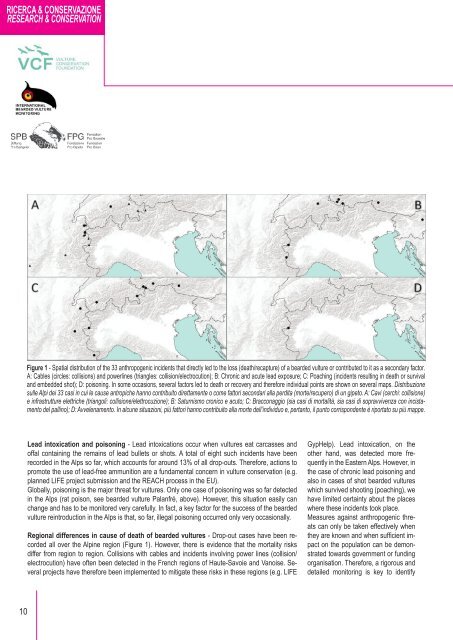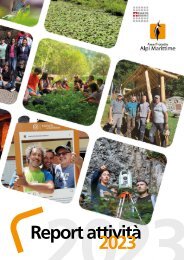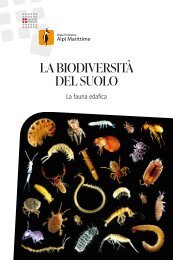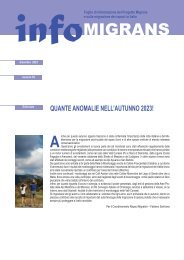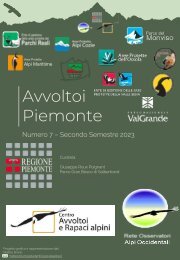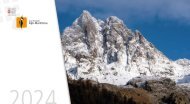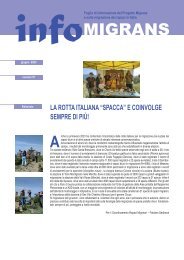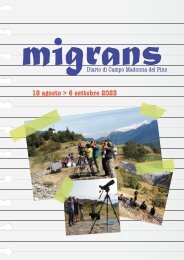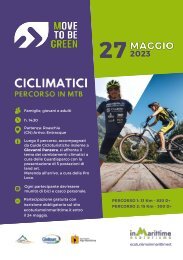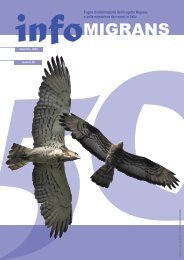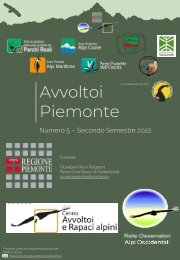infoGIPETO n.37 |dicembre 2020
Periodico d'informazione sul progetto di reintroduzione del gipeto.
Periodico d'informazione sul progetto di reintroduzione del gipeto.
Create successful ePaper yourself
Turn your PDF publications into a flip-book with our unique Google optimized e-Paper software.
RICERCA & CONSERVAZIONE<br />
RESEARCH & CONSERVATION<br />
Figure 1 - Spatial distribution of the 33 anthropogenic incidents that directly led to the loss (death/recapture) of a bearded vulture or contributed to it as a secondary factor.<br />
A: Cables (circles: collisions) and powerlines (triangles: collision/electrocution); B: Chronic and acute lead exposure; C: Poaching (incidents resulting in death or survival<br />
and embedded shot); D: poisoning. In some occasions, several factors led to death or recovery and therefore individual points are shown on several maps. Distribuzione<br />
sulle Alpi dei 33 casi in cui le cause antropiche hanno contribuito direttamente o come fattori secondari alla perdita (morte/recupero) di un gipeto. A: Cavi (cerchi: collisione)<br />
e infrastrutture elettriche (triangoli: collisione/elettrocuzione); B: Saturnismo cronico e acuto; C: Bracconaggio (sia casi di mortalità, sia casi di sopravvivenza con incistamento<br />
del pallino); D: Avvelenamento. In alcune situazioni, più fattori hanno contribuito alla morte dell’individuo e, pertanto, il punto corrispondente è riportato su più mappe.<br />
Lead intoxication and poisoning - Lead intoxications occur when vultures eat carcasses and<br />
offal containing the remains of lead bullets or shots. A total of eight such incidents have been<br />
recorded in the Alps so far, which accounts for around 13% of all drop-outs. Therefore, actions to<br />
promote the use of lead-free ammunition are a fundamental concern in vulture conservation (e.g.<br />
planned LIFE project submission and the REACH process in the EU).<br />
Globally, poisoning is the major threat for vultures. Only one case of poisoning was so far detected<br />
in the Alps (rat poison, see bearded vulture Palanfré, above). However, this situation easily can<br />
change and has to be monitored very carefully. In fact, a key factor for the success of the bearded<br />
vulture reintroduction in the Alps is that, so far, illegal poisoning occurred only very occasionally.<br />
Regional differences in cause of death of bearded vultures - Drop-out cases have been recorded<br />
all over the Alpine region (Figure 1). However, there is evidence that the mortality risks<br />
differ from region to region. Collisions with cables and incidents involving power lines (collision/<br />
electrocution) have often been detected in the French regions of Haute-Savoie and Vanoise. Several<br />
projects have therefore been implemented to mitigate these risks in these regions (e.g. LIFE<br />
GypHelp). Lead intoxication, on the<br />
other hand, was detected more frequently<br />
in the Eastern Alps. However, in<br />
the case of chronic lead poisoning and<br />
also in cases of shot bearded vultures<br />
which survived shooting (poaching), we<br />
have limited certainty about the places<br />
where these incidents took place.<br />
Measures against anthropogenic threats<br />
can only be taken effectively when<br />
they are known and when sufficient impact<br />
on the population can be demonstrated<br />
towards government or funding<br />
organisation. Therefore, a rigorous and<br />
detailed monitoring is key to identify<br />
10


